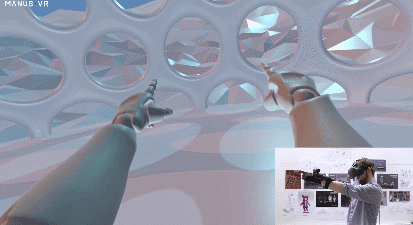Contemporary VR control methods designed for use with Oculus Touch and HTC Vive headsets function much like traditional video game controllers, intended to be held naturally in one’s hands and operated via motion controls, joysticks, and a “grip” button used to pick up virtual objects and interact with the game world. While these control schemes are impressive in their own right, it is inevitable that new control devices and technologies will emerge as VR continues to grow in popularity among mainstream consumers. Below, we’ve outlined several control solutions that we believe have serious potential to fundamentally change the way users interact with VR.
Valve’s ‘Knuckles’
Valve is currently developing a prototype VR controller dubbed ‘Kunckles.’ Similar to existing Oculus Touch and HTC Vive controllers, each hand features motion tracking, face buttons, a trackpad, and a “grip” button. What differentiates ‘Knuckles’ from its counterparts, though, is its built-in adjustable strap that tightens around the user’s knuckles, allowing one to let go of the controller without dropping it. This small yet ingenious design feature is further enhanced by sensors in the controller’s grip to detect the placement of middle, ring, and pinky fingers. Unlike current generation technology, Valve’s ‘Knuckles’ controller is capable of tracking individual finger movements, enhancing immersion as users can manipulate individual digits when interacting with virtual objects. ‘Knuckles’ will be compatible with all existing HTC Vive hardware, however Valve has yet to announce a release date or price for the device.

![]()
VR Gloves
Taking hand and finger tracking technology to an entirely new level, devices like the CaptoGlove, Hi5 VR Glove, Manus VR Glove, and others offer wearable motion tracking VR Glove technology capable of translating real life hand, finger, and wrist actions into digital inputs. VR Gloves discard conventional buttons and joysticks in favor of a revolutionary wearable design- at a steep price. Most VR Glove controllers remain in a developmental stage and as a result are generally more expensive than comparable motion tracking controllers. Glove VR control solutions undoubtedly offer a more immersive VR control experience than plastic handheld devices, but widespread adoption of VR Glove technology is unlikely until it reaches a price point more in line with its controller competitors.

Leap Motion Controller
A USB-powered sensor designed to sit on a user’s desk and capture hand and finger motions as input in lieu of using a computer mouse, the Leap Motion Controller released in 2013 to mixed reviews. While the technology impressed some, many users still preferred using a mouse to operate their PC over waving their arms. However, shortly after its launch Leap Motion released a software update for their device containing an experimental VR tracking mode dubbed ‘Orion.’ Users found that when strapped to the front of a VR headset, the Leap Motion Controller allowed for accurate hand and finger tracking without the need for any held or worn control devices. The company now sells VR Developer Mounts for Oculus Rift and HTC Vive on its website and plans to implement their technology directly into future VR headsets. The Leap Motion Controller further blurs the line between real life and virtual reality by allowing users to utilize their own body as input, eliminating the need to hold or wear any additional peripherals.

What do you think of these novel VR control solutions? Is there a product or technology you’re excited about that we missed? Let us know via our Facebook or Twitter!